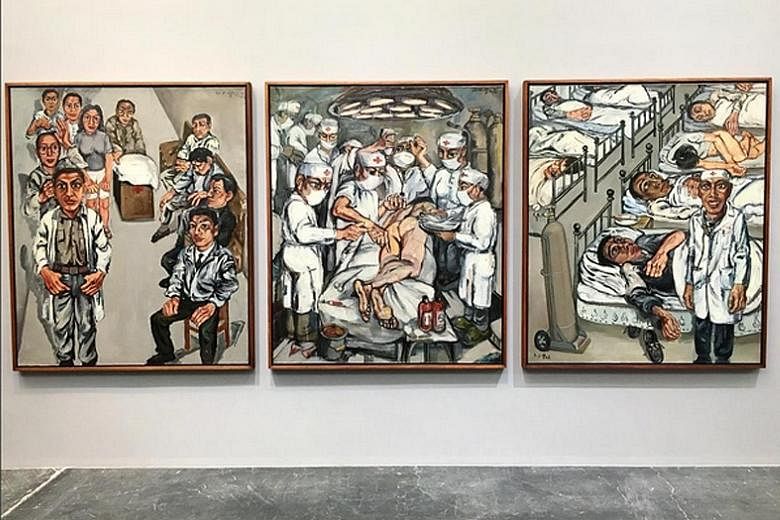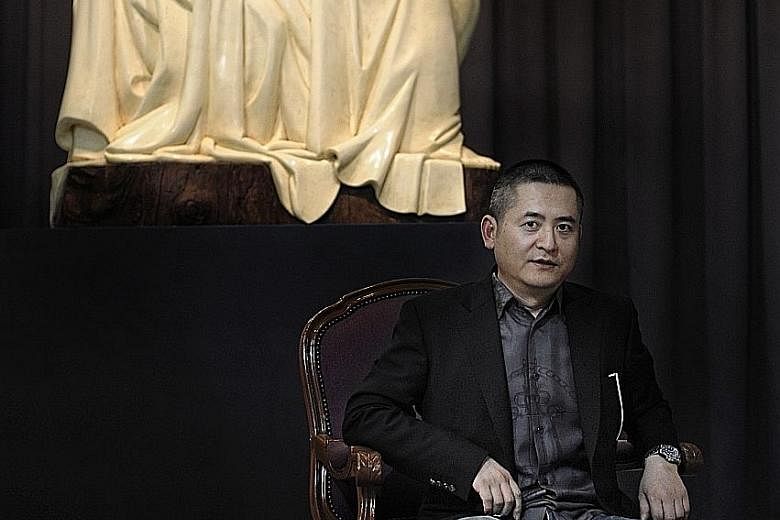NEW YORK • To get a sense of the remarkable growth of the Chinese contemporary art market, look no further than artist Zeng Fanzhi.
Zeng, 51, has seen his work bring in the second-highest price for a living Chinese artist, according to Artnet. In 2013, his 2001 tribute to Leonardo da Vinci's The Last Supper sold for US$23.3 million at Sotheby's Hong Kong, setting what was then a record auction price for a work by a contemporary Chinese artist.
A week ago, the Ullens Center for Contemporary Art in Beijing unveiled Zeng Fanzhi: Parcours, a major retrospective that runs through Nov 19. The exhibition covers almost three decades and features works central to the artist's oeuvre, including his early Hospital series, which he painted based on memories of a hospital where he used the toilet because he did not have one at home.
It also includes his Masks series, which depicts well-dressed urbanites wearing white masks, a commentary on China's rapid social transformation in the mid-1990s, and his haunting, thicket-filled abstract landscapes. And, for the first time in China, the show displays Zeng's most recent works - a series of ink on paper - which signal a shift by the artist towards an engagement with ancient Chinese painting.
In an interview, he discussed traditional Chinese culture, China's art market and mixing politics and art.
Your latest works on paper suggest a turn towards traditional Chinese culture. Why the shift?
This shift came about for several reasons. For example, I like designing gardens and, to do that, you have to have a certain appreciation of the natural beauty of things, such as stones and plants. Emperor Huizong's painting, Listening To The Qin, is the most beautiful painting from the Song dynasty. For more than 10 years, I've been observing the beauty of the pine tree in that painting.
Over time, I began to realise that traditional things have their own beauty. Perhaps it also has to do with my age. When you reach a certain age, you naturally begin to turn to a spirit of introspection.
What does the motif of the branches signify in your large- scale abstract landscapes?
People in the West initially thought of it as a type of expressionistic brushwork. Early on, I, too, thought of it like this. But later, I began to think of the branches as being related more to traditional Chinese calligraphy. So, when painting, I would pay special attention to the rhythm and the spirit of the brush stroke with the belief that each stroke has its own movement and internal beauty.
Looking back at your career through this retrospective, is there a particular period of time that you feel nostalgic about?
Not really. Each of the works represents my life and feelings at that particular time and all the stages are closely linked. For example, I went from doing large-scale abstract landscape paintings to making small works on paper. All these stages have a certain element of contrast.
In the beginning, most of the collectors who bought your work were foreigners. Then, you started to see more interest from Chinese collectors. Can you describe this shift?
I moved to Beijing in 1993. The people who bought my works then were mostly Westerners, such as those who worked in the embassies or taught at universities.
Then, around 2004, we started to see more Chinese people buying art. I remember it clearly because before, no one was buying and, for 10 years or so, the prices for our works had not changed. We didn't know these new Chinese collectors and we couldn't tell if they liked the art.
Around 2007, we started to see a lot of people flipping works. At first, I thought the buying was good, but when the market began to overheat, I went on alert. I didn't sell to a person who wanted to buy 20 of my paintings because I was suspicious.
Then what happened?
In 2008, there was the financial crisis and, all of a sudden, a lot of galleries in China closed. Some people had bought so many paintings. One person even bought 100 paintings from one artist.
After having gone through 2008, most of the artists here have matured. The art market is something you can't mess with. Just take it one step at a time, develop slowly and work with galleries to sell works to people who like art and not to those who speculate. Now that we've worked with a lot of international galleries and museums, artists here get it.
Do you ever feel pressure either to avoid or to engage with politics in your work?
I think every artist chooses how to express himself. I choose to create works on subjects that I am interested in.
However, it doesn't mean that I'm not paying attention to society. For example, in my early Hospital works, I was interested in basic issues of humanity. I pay attention to society and to the lives of people around me.
I won't make something just for the sake of being provocative.
NYTIMES


